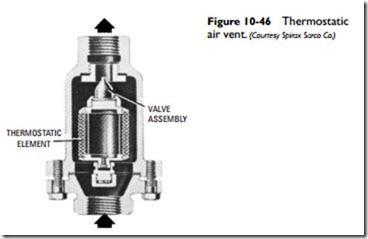Troubleshooting Expansion Tanks
An undersized expansion tank or one that is completely filled up with water will cause the boiler pressure to increase when the water heats. Because the expansion tank is too small or too filled with water to absorb the excess pressure, the relief valve will begin to drip. The dripping relief valve is only symptomatic of the real problem, and replacing the valve will in no way solve it.
There is not much you can do about an undersized expansion tank except replace it. As a rule-of-thumb, expansion tanks should be sized at 1 gal. for every 23 ft2 of radiation, or 1 gal. for every 3500 Btu of radiation installed on the job. In Table 10-3, the allowance is slightly higher.
If the problem is a completely filled tank, it should be partially drained so that there is enough space to permit future expansion under pressure. The first step in draining an expansion tank is to open the drain valve. The water will gush out at first in a heavy flow and then tend to gurgle out because a vacuum is building up inside the tank. Inserting a tube into the drain valve opening will admit air and break the vacuum, and the water will return to its normal rate of flow. After a sufficient amount of water has been removed, the drain valve can be closed.
Air Eliminators
Sometimes air pockets will form in the pipelines of steam or hot- water heating and cooling systems and retard circulation. One method of eliminating these air pockets is to install one or more air eliminators at suitable locations in the pipeline.
An air eliminator (or air vent) is a device designed to permit automatic venting of air. These automatic venting devices are avail- able in a number of sizes, shapes, and designs. Not only are air eliminators used for venting convectors, baseboard radiators, and other heat-emitting devices; they are also frequently used for this purpose on overhead mains and circulating lines.
Three types of air eliminators (air vents) used in steam or hot- water heating and cooling systems are:
• Float-type air vents
• Thermostatic air vents
• Combination float and thermostatic air vents
A float-type air vent (see Figure 10-45) consists of a chamber (body) containing a float attached to a discharge valve by a lever assembly. The float-controlled discharge valve vents air through the large orifice at the top. The float action prevents the escape of any fluid, because the float closes the valve tightly when it rises. When the float drops, the lever assembly pulls the valve from its seat, and the unit discharges air.
Float-type air vents are available for hot-water heating and cooling systems to 300 psi and low-pressure steam heating systems to 15 psi. A float-type air vent used in a steam heating system should be equipped with a check valve, which prevents air return under vacuum.
Steam cannot be maintained at its saturated temperature when air is present in the system. As shown in Table 10-4, the temperature of the steam decreases as the percentage of air increases. A thermostatic air vent is specifically designed for removing air from a steam system. The one shown in Figure 10-46 consists of a valve head attached to a bellows, operating in conjunction with a thermostatic element. Its operating principle resembles that of a thermostatic steam trap. When air is present, the temperature of the steam drops. The temperature drop is sensed by the thermostatic element, which causes the valve in the vent to open and discharge the air. When the air has been discharged, the temperature of the steam rises, and the valve closes tightly.
In some special applications, it is necessary to use an air elimina- tor that will close when the vent body contains steam or water and opens when it contains air or gases. Combination float and thermo- static air vents have been designed for this purpose.
A combination float and thermostatic air vent (see Figure 10-47) consists of a vent body or chamber containing a float attached to a valve assembly. The float rests on a thermostatic element that responds to the temperature of the steam. The operation of this ele- ment is similar to the one used in a thermostatic steam trap. When the vent body is filled with air or gas, the float is at its lowest point, causing the thermostatic bellows to contract. Because the float is at a low point in the vent body, the head is moved off the valve seat and the vent discharges the air or gas. The head moves up and
closes the valve when either water or steam enters the vent body. The entry of water into the vent body forces the float upward and eventually closes off the valve. The entry of steam, on the other hand, causes the thermostatic bellows to expand and force the float upward, closing the valve.


